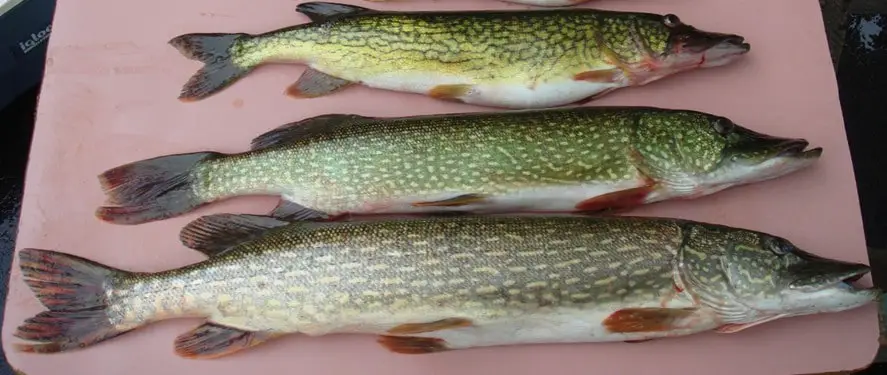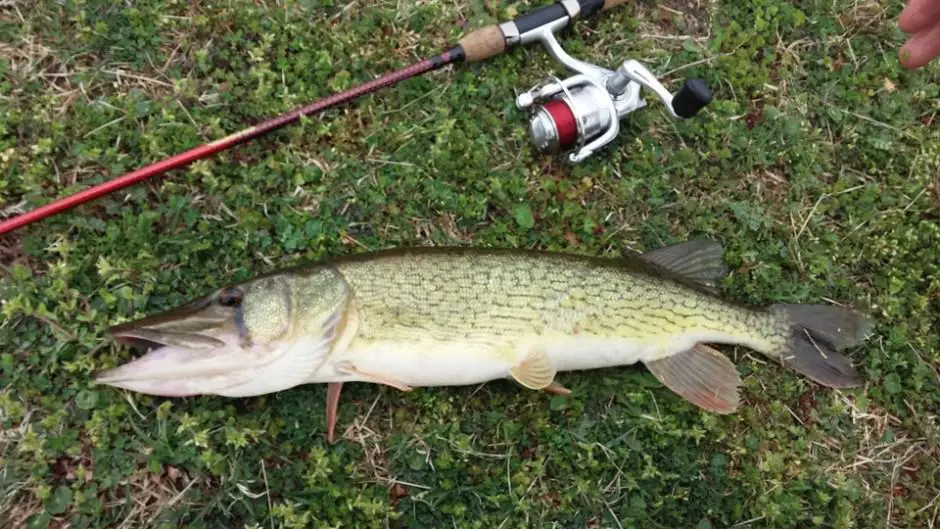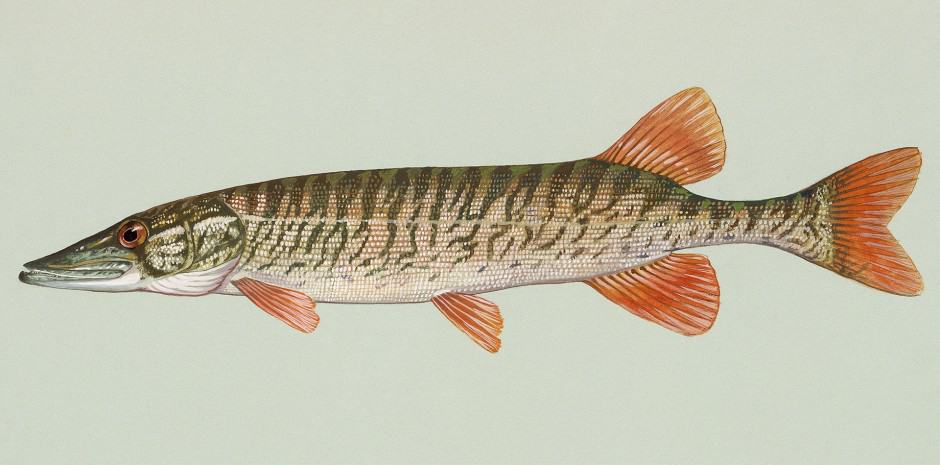Northern pike and pickerel belong to the same family of fish, and it’s very easy to mix them up. In fact, if you’re not paying attention it’s incredibly easy.
Few fish look as similar as these two closely related cousins, to the point where it can be pretty easy to tell them apart.
The Northern pike is larger in size, slightly darker in color, with a distinct horizontal spotted pattern. As compared to various pickerel that are smaller, have varied horizontal/vertical patterns, and different coloration that differs from their larger cousins.
There are more specific ways of telling apart the three types of pickerel that are related to pike apart and we’ll be doing the deep dive on all of them today.

How to Tell A Northern Pike & Pickerel Apart
This section will focus heavily on northern pike vs. chain pickerel since those are the two species that are often confused. They look the most alike among any two fish in the Essox family, barring the rare hybrids.
When someone is having an issue telling whether a fish is a pike or pickerel, 99% of the time a chain pickerel is involved.
Northern Pike vs. Chain Pickerel
Pickerel and pike are cousins, both fish from the Essox family. This isn’t hard to believe because they clearly look like related fish but it’s the chain pickerel that causes the overwhelming number of misidentifications.
So how do you tell northern pike apart from chain pickerel?
Look at Size of Fish
One quick way to tell apart the big ones is to look at the size/weight of the fish. The world record for the chain pickerel was 9lbs, 6oz. That’s it. And that world record has stood for 60 years at this point.
Northern pike frequently reach sizes of 20, 30, or even 40 lbs. If the fish is ten pounds or above then unless you’ve made a once in a century catch then it is almost certainly a northern pike.
Most pike-like fish at 7-9 lbs will also be northern pike, however there are some monster chain pickerel that reach that size.
But anything above that and you can be pretty much 100% sure that the fish is a northern pike.
Look at the Side Pattern
The side patterns are different between these two fish, although with smaller ones it can be a little bit harder to notice. Both have darker green skin with spots that can look like dots or lines similar to Morse Code moving in horizontal lines across the fish.
The big difference is that the pattern on pike is more defined. Each spot is distinctive, fully contained, and you will see the darker skin around all of them.
These are distinctive marks and each one has its own space regardless of size.
With the chain pickerel, on the other hand, the spots start blending together into one another. This is especially true towards the tail or more back end of the fish.
You can see that clearly in the picture above where the pike’s pattern stays clear, but on the chain pickerel what starts out as a distinctive pattern merges to longer lines or blotches of lighter coloration.
This is a dead giveaway for whether you caught a northern pike or if you’re holding a chain pickerel.
Coloration Differences
Chain pickerel tend to have a lot more yellow and yellow-green color while most pike are mostly different shades of green.
There are some exceptions as juvenile pike between 1-3 years old tend to have some yellow in vertical patterns up the side but otherwise for adult fish yellow is a giveaway that the fish is a pickerel and not a pike.
Look for the Teardrop Under the Eye
Fish in the Essox family all tend to have some degree of a teardrop mark underneath the eye. There is a very thick and distinctive dark mark underneath the eye. This is thick and pronounced for chain pickerel. Or for other pickerel, as well.
This mark exists with a northern pike, but it is much thinner and the least distinctive among the Essox fish species. The video just a little bit further down has a section that shows this very clearly.
If the teardrop is thin, you’re looking at a pike. If it’s thick & wide, it’s a pickerel. It’s also worth noting that the pike teardrop tends to be vertical, mostly straight down from the eye, while on the pickerel they angle back.
Count submandular pores underneath the jaw
If you look at the underside of a fish in the Essox family, you will see pairs of pores in the jaw. This is something that fish in the pike use in order to sense movement around them and help them locate potential movement of prey.
This isn’t as clear a way for telling fish apart, but over 90%+ pike will have exactly 5 sets of pores. They can also have four or have six, one above the average in each direction, but that’s it. The majority of the time pike will have exactly five.

Chain pickerel can have anywhere from three to five pairs of these pores. There’s no clear number that is a majority, but it does give you another way to identify some of these fish.
Three pairs is definitely a pickerel. Four pairs is probably a pickerel. Five pairs could be a pike or pickerel. Six pairs is definitely a pike.
Other defining features between pike vs. pickerel
- Northern pike have spots on their fins, pickerel do not
- Pickerel tend to have more spots than northern pike
- The pike’s jawline curls further back and close to the eyes than the pickerel
- The pike’s back fin has less of a “split” between halves than the pickerel’s
- A pike’s back fin can have streaks in it
Great Pike Family Identification Video
Northern Pike vs. Grass Pickerel
The grass pickerel’s coloration is darker than other pickerels. This makes them less yellow and a lot more dark green, which to the untrained eye could make them appear like very small pike in some areas but there are several good reasons why this fish is rarely mistaken for a pike up close.

Size matters, baby
Grass pickerel are a very small fish. In fact, they almost never grow bigger than 12 inches in length. That makes for an incredibly young and small pike (all pike are this big or bigger after 2 years), which is a major reason these two are almost never mistaken from each other.
A grass pickerel could only look like the absolute smallest of young pike. anything above 12 inches is a pike. Simple as that.
Look at the direction of the spot pattern
On grass pickerel the patterns of spots and dashes run vertically instead of horizontally. On pike, even young pike, they run horizontal. This is a very easy way to avoid the dark green color trap and figure out what species the fish is.
Special fish scales
One final way to tell a baby “throw it back” pike from a small “throw it back” grass pickerel are the scales. Grass pickerel have fully scaled cheeks. Northern pike have only partially scaled cheeks.
Although it shouldn’t really come down to this level of detail. Usually you can tell once it’s out of the weeds and in the boat exactly what you’ve hooked.
Northern Pike vs. Redfin Pickerel
The redfin pickerel is another member of the Essox family, and another fish that is fairly easy to tell apart from a northern pike. Especially when compared to the chain pickerel.

Size of fish matters (again)
Redfin pickerel are another fairly small fish. Full grown adults are rarely bigger than 10 inches long and never more than 14 inches. If the fish is longer than that, it is definitely a northern pike.
Pattern on the fish
The pattern on the side of a redfin pickerel is very Muskie-like. The lines on its side are vertical, running up and down. This is the complete opposite of the pike, whose pattern is horizontal and runs with distinct small lines or dots (similar to Morse code).
The lines on a redfin pickerel are also much bigger and connected near the top of the fish’s back. They look very much like the pattern of a muskie and you should have no problem telling them apart from a northern pike.
Look at the tail fin
One distinct feature of the redfin pickerel that sets it apart is the tail. Unlike other members of the Essox family the redfin pickerel has a very distinctive tail fin. It narrows out incredibly before forming a very distinctive tail fin area from the rest of the body.
That’s not the case with pike, muskie, or other pickerel. Their dorsel fins are a bit off from the body, but they look very much connected to the main part of the fish’s body.
This distinctive narrowing that separates the body from the tail tells you the small fish you caught is a redfin pickerel and not a baby pike. Or the baby muskie it more likely looks like.
Look at the teardrop
One of the few consistently good pieces of advice when trying to see if a northern pike or pickerel is the small fish you caught. The teardrop of the redfin pickerel will curve backwards at an angle.
For a northern pike, it will be pretty much vertical and heading straight down.
Northern Pike vs. Pike-Pickerel Hybrid
These fish are incredibly rare, and the most reliable way to find out about them is to talk to a fishing guide in an area with both pickerel and pike for several decades.
Like tiger muskie, these hybrids are unusual to the point where they are that rarely found naturally in the wild. But they look even more like regular pike than the chain pickerel responsible for most mistakes identifying a fish that could be either/or.
The best way to determine the difference is to thoroughly understand the features that are northern pike only or pickerel only.
This is important because a pike-pickerel hybrid can have features of both the pike and the chain pickerel. This means sometimes you have a fish that has a vertical tear drop but whose spotted pattern merges into pickerel-like blotches near the fin.
Each pike-pickerel hybrid can have any combination of these traits, so if you find a fish that clearly has features that are pike-only AND pickerel-only, then you may have a hybrid.
The middle picture above shows just how much of a merge between the two a hybrid can be.
Defining Features of a Northern Pike (Compared to Pickerel)
One of the best ways to tell a northern pike apart from various pickerel or even the unique hybrid is by understanding the features that are “pike only.” When you know these features it becomes much easier to figure out when that mid-sized 6-10 lb fish is a pike or a monster pickerel.
These are some of the most common pike traits that can help you identify these in waters they share with pickerel.
- Pike are sizeable fish that easily grow above 10 lbs, often after only a few years
- The pattern on northern pike run horizontally and the spots don’t “merge” or “blot” together
- The jawline goes further back on the pike and it curls slightly towards the eye
- Vertical teardrop mark by eye is narrow and goes straight down
- Some pike have 6 pairs of submandiular pores, no pickerel have that many
- Pike have partly scaled cheeks while all pickerel have fully scaled cheeks
In Conclusion
Even for experienced anglers it can sometimes take a little bit of time to learn how to quickly and accurately tell pickerel and pike apart. Especially in bodies of water where the two fish intermingle.
However, by following the advice and information in this article you’ll be set and know how to tell them all apart.
